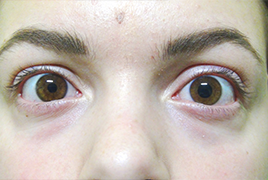Anisocoria is a condition characterized by an unequal size of the eyes’ pupils. There is a broad spectrum of aetiological factors including benign and also life- threatening situations. The most important point is the ability to find the anatomical location of the pathology. Understanding to the anatomical, physiological and pharmacological influences helps us to solve the diagnostic challenge. In the article authors present the issue of the anisocoria in the childhood through two case presentations. Causes of an unequal size of the eyes’ pupils are in this two cases different. In both of the cases the anisocoria is temporary with spontaneous resolution without any therapy. Diagnostic challenge is well- described with the analysis of important Pilocarpin pharmacological tests. Pharmacological diagnostic tests are a very effective method to differentiate between the pharmacological mydriasis and the mydriasis caused by another factor. Strictly taken patient´s history with targeted questions searching for recent contact with some drugs, plants or medications is crucial. Sometimes it is necessary to consider an unusual diagnosis – benign episodic unilateral mydriasis.
- The Influence of the Cornea of Intraocular Pressure Measurement by ICARE PRO and ORA
- The Use of Optical Coherence Tomography in Chiasmal Compression
- Methods of Improving the Visual Functions in Patients with Stable Maculopathy – Pilot Results of a New Study
- Ranibizumab for the Treatment of Choroidal Neovascularisation due to Causes other than Age-Related Macular Degeneration
- Pupillary Abnormalities in Childhood – 2 Case Presentations
- Selective Angiography with the Possibility of Thrombolysis in Patients with Central Retinal Artery Occlusion

